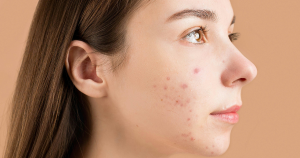Founded in Nanjing China in 2008, Shein is a global online fast fashion retailer that in recent years has become the most googled fashion brand, overtaking industry giants like Zara, Nike and Adidas in 113 countries. Notoriously sketchy on its history and details, Shein is estimated to have 10,000 employees worldwide, working with hundreds of factories to produce over 1.3 million new items of clothing per year.
Shein has come under massive fire over the last few years for its devastating environmental impact (including astonishingly high levels of water pollution, textile waste and carbon emissions) and its unethical labour conditions. Lesser covered however, is its impact on the health of its customers.
So how much is that cheap top really impacting your health? Can clothing really disrupt your hormones? Let’s break it down
Synthetic Materials Used in Fast Fashion
Shein, like most fast fashion brands, relies heavily on synthetic materials like polyester, nylon, acrylic, synthetic leather and more. These materials are cheap and fast to produce, making them extremely desirable for fast fashion retailers for who’m speed and price are their modus operandi.
But these aren’t just fabrics, they’re basically wearable plastic. Multiple studies have linked synthetic materials to impaired hormonal function and a disrupted endocrine system.
And to make matters worse, they’re often treated with a toxic cocktail of chemicals to achieve those “desirable” properties like wrinkle resistance or water repellency. Spoiler alert: your endocrine system is not a fan.
Let’s break down this chemical sh*t show:
- Phthalates: these salts or esters are used to make plastic more flexible and are often found in printed designs. These have been linked to reproductive problems including early puberty in girls and damage to sperm in men.
- Perfluorinated chemicals (PFCs): used for water-resistant coatings and increase the risk of thyroid disorders in adults
- Azo dyes: These create those vibrant colors that are not necessarily found in nature. Around half of these dyes contain estrogen disrupting properties.
- Formaldehyde: Yes, the same stuff that’s used for embalming dead bodies! It prevents wrinkles in clothes but triggers inflammation in lungs through immune and oxidative stress
- Flame retardants:
Now, I can hear the skeptics: “But it can’t be getting in to my body simply by wearing it “. Well, your skin is your biggest organ and is highly absorbable, with and many synthetic products include properties that can penetrate the skin barrier and enter in to your blood stream.
Potential Health Impacts
Now, I can hear the skeptics: “But I’ve been wearing this stuff forever, and I feel fine!” Sure, you might feel okay now, but these endocrine disruptors are sneaky. They’re playing the long game, potentially leading to:
- Fertility issues
- Irregular periods
- Mood swings
- Weight gain or difficulty losing weight
- Skin problems
- Fatigue
How to Avoid Harmful Chemicals in Clothing
Let’s be real – this isn’t just a Shein problem. It’s a symptom of a larger disease: a capitalist system that values profit over people. These companies know about these risks, but as long as we keep buying, they’ll keep producing. It’s a vicious cycle fuelled by our insatiable appetite for newness and the illusion of affordability (since clothing that constantly needs to be replaced works out more expensive over time).
So, what can we do? First, we need to wake up and smell the formaldehyde. Knowledge is power, and now that you know about these issues, you can make informed choices. Here are some harm reduction strategies:
- Avoid fast fashion brands like Shein
- Keep an eye out for synthetic materials when shopping for clothing
- Invest in fewer, higher-quality pieces made from natural fibers like linen, hemp, bamboo, wool and organic cotton
- Wash new clothes before wearing them. It won’t solve everything, but it can help remove some surface chemicals
- Avoid clothes with strong chemical smells. If it smells like a laboratory, it probably shouldn’t be on your body
- Look for certifications like OEKO-TEX or GOTS, which ensure stricter chemical standards in clothing manufacturing
- Limit your exposure. If you are planning to wear synthetic materials, make sure to interchange it with natural fibers.
- Support brands that prioritize sustainability and ethical production
So, does wearing Shein clothing affect your hormonal health? The answer is a resounding, capitalism-critiquing “YES.” It’s time we stop letting fast fashion giants off the hook and start holding them accountable for the true cost of their products.







